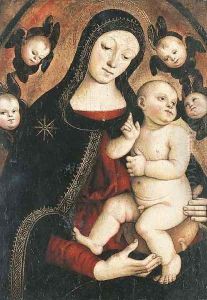Master Of The Orte Madonna Paintings
The Master of the Orte Madonna is an anonymous Italian painter from the 15th century, active during the Early Renaissance period. The moniker 'Master of the Orte Madonna' was given by art historians to identify the artist or workshop responsible for the creation of the 'Madonna and Child' painting, which was originally located in Orte, near Viterbo. This name is a notional designation, typical of art historical practice for unidentified artists whose work exhibits distinctive style or characteristics.
The Master of the Orte Madonna's exact birth and death dates are not known, and very little is documented about his life. The artist's work came to light through stylistic analysis of the painting that gave him his name, which now resides in the National Gallery in London. Art historians have attributed this work to him based on the distinctive style, composition, and technique observed in the painting.
The 'Madonna and Child' by the Master of the Orte Madonna is noted for its graceful figures, serene expressions, and the use of light and shade that suggests volume and form. This work suggests that the master was influenced by the Florentine school, particularly by artists such as Fra Angelico and Filippo Lippi, who were known for their tender and intimate renditions of the Madonna. However, the Master of the Orte Madonna also displays a unique style that distinguishes his work from his contemporaries.
Due to the lack of records, it is difficult to construct a comprehensive biography of the Master of the Orte Madonna. The study of his surviving work suggests that he was part of the vibrant artistic scene of the Early Renaissance, contributing to the development of religious iconography with his own interpretations. His identity remains a mystery, and his oeuvre may be broader than currently recognized, with potential undiscovered works attributed to other artists or remaining anonymous. The title 'Master' indicates that he was likely a professional artist of some repute, possible with a workshop and apprentices, as was common during the period.
Art historians continue to examine the few pieces attributed to the Master of the Orte Madonna in the hope of uncovering more about his techniques, influences, and place within the broader context of Renaissance art. Despite the limited information, the enduring beauty of his known work continues to speak to the skill and sensibilities of this enigmatic artist.
